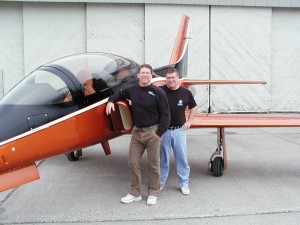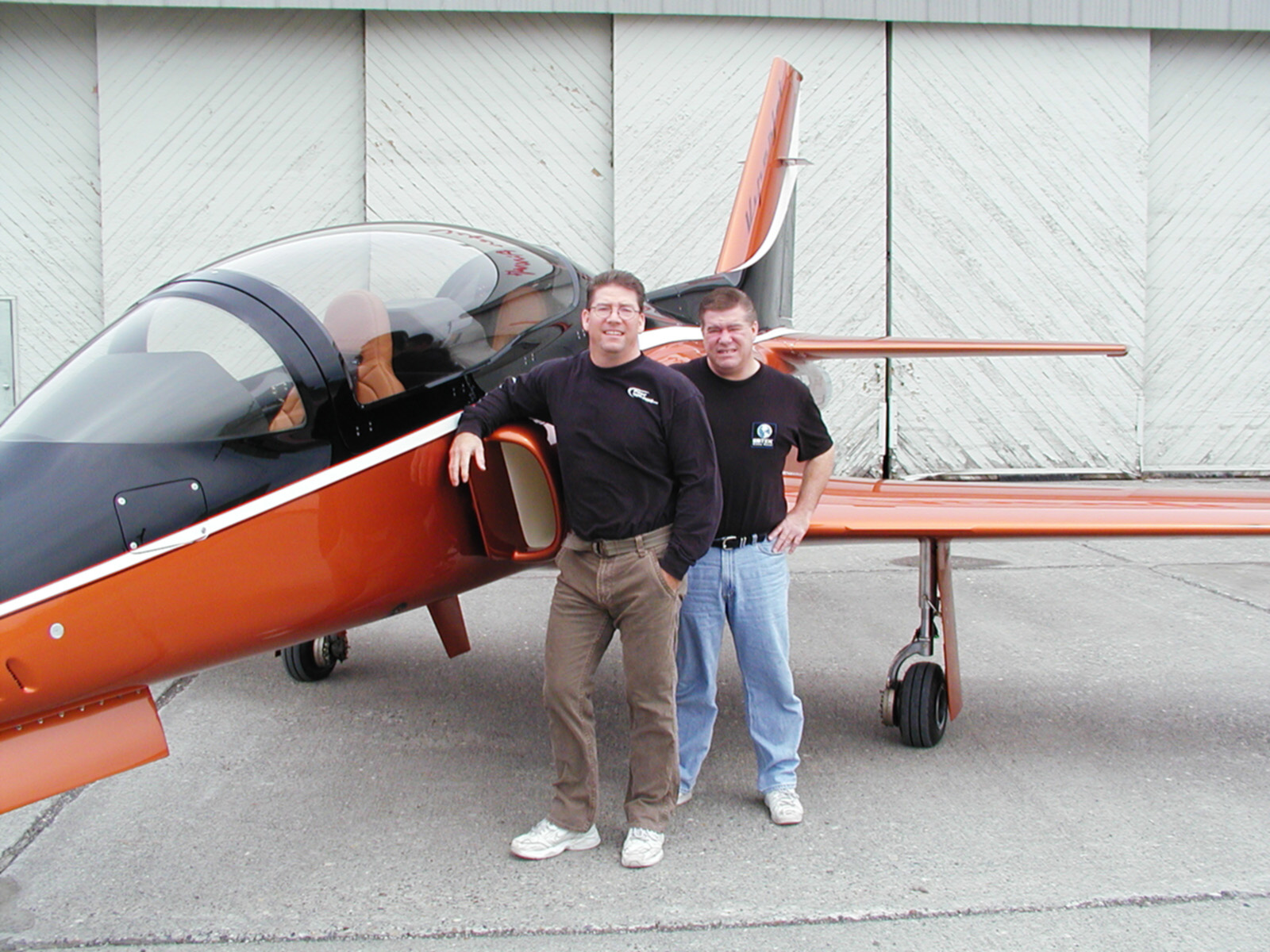
Dan (left) and Scott Hanchette are ready to show off their Viperjet MKII Executive at the Porsche Business Aircraft & Jet Previews at Boeing Field and Centennial Airport. It’s a luxury version of the popular kit-built aircraft made in Pasco, Wash.
By Terry Stephens
The Hanchette brothers from Pasco, Wash., once again have heads turning everywhere their Viperjet flies. Earlier this year, they upgraded the high-performance plane to a luxury version, the MKII Executive, with extra comfort and features.
Designed for corporate CEOs, lawyers, physicians and other professionals who want cross-country, aerobatic and fighter-style performance in a single aircraft, the kit-built executive jet sets a new standard for comfort, appearance and electronics in kit planes, said Dan Hanchette, co-developer with brother Scott.
“The MKII design responds to requests and inquiries from people about a luxury version of the Viperjet,” he said. “People are using our planes for corporate trips, instead of flying their larger aircraft with seven or eight empty seats. Some people live that way. They often like to fly by themselves or fly a plane that’s more fun. The only downside, we hear, is that the Viperjet doesn’t have all the ‘fancies’ like their corporate jets.”
The Hanchettes have taken care of that concern, creating a luxury cockpit with new custom-contoured side panels, accented with layered Brazilian burl wood. Adjustable front and rear seats, each covered in Italian leather, are similar to those found in a Ferrari. Also, the two-place cabin now has a new climate-controlled environment for more comfort.
A key feature of the new executive version is top-of-the-line avionics, providing twin glass screens and integrated flight systems by OP Technologies. If the passenger tires of seeing spectacular views through the new tint glass canopy, movies can be viewed on the custom-designed entertainment system.
Powering the new Viperjet MKII Executive, now arrayed in vivid new orange-copper pearl, black pearl and white accented livery, is a versatile General Electric J-85/CJ-610 power plant generating 2,850 pounds of thrust and a wide range of performance. That standard engine has made the Viperjet popular for its amazing climb rate of 10,000 feet per minute—compared to 3,000 fpm for the L-29 Czechoslovakian fighter jet that’s garnered much attention recently as converted civilian models in the United States.
The Viperjet has a stall speed of 77 knots.

Ready to go on the ramp outside its hangar in Pasco, the Viperjet MKII Executive is designed for corporate and private pilots who want comfort in their cross-country flights or aerobatic maneuvers.
“That’s pretty unreal when you’re talking about jets,” Hanchette said. “Plus, it’s a very stable instrument flying platform and provides speeds up to 488 knots.”
The first Viperjets had a maximum range of 750 to 1,000 miles with 260 to 330 gallons of fuel, a takeoff roll of 1,000 to 1,500 feet—rotating at 85 kts—and a landing distance of 2,500 feet.
“The performance is still there, even for people who don’t want the over-the-top add-ons that some of the corporate pilots want, so someone with a lower budget can still build a very nice Viperjet,” he said. “We offer a wide range of avionics packages, which can change the price considerably.”
Depending on options, Hanchette said a standard version of the Viperjet would cost $500,000 to $575,000, once it’s totally assembled by the customer. For the new Executive model, builders should expect a ready-to-fly cost of $650,000 to $795,000.
“The Viperjet’s the least expensive plane in its class, yet the performance well exceeds its competition,” he said.
Viperjet wasn’t an overnight success. The brothers began designing the Viperfan, their first plane, in the mid-1980s. Composites weren’t in common use at the time, so designing took several years while waiting for the right materials. In 1996, they began tooling up for the prototype, founding Viper Aircraft Corporation and hiring Composites Universal Group in Scappoose, Ore., to make the molds and parts.
Three and a half years later, the paper drawings finally evolved to a flyable aircraft. But, as production progressed, the brothers decided to install a jet engine, rather than the Continental engine with a five-blade propeller. The performance greatly improved.
By October 1999, the first Viperjet was airborne, but proved to be underpowered with its GE T58, producing only about 750 pounds of thrust. The Hanchettes settled on GE’s J85, the civilian model of its successful CJ610, with 2,850 pounds of rated thrust. Even though they already had models sold, they redesigned the plane for the more powerful engine, added more space for fuel, a new landing gear to handle the additional weight, new wings, tail, engine bay and instrumentation for what would become the Viperjet MKII.
After upgrading the plane, at no extra cost to those who already had ordered the Viperjet, the Hanchettes’ test pilot, Len Fox, successfully flew the new prototype from Pasco Airport (PSC) on June 12, 2005.
Like other kit-planes, the Viperjet isn’t certified. That would have required an investment up to $100 million for a lengthy, detailed government process, resulting in price tags three to four times above the first model’s, Hanchette said.

The new Viperjet MKII Executive features Italian leather seats usually found only in Ferraris, plus contoured panels accented with layered Brazilian burl wood and a new climate-controlled environment for more comfort.
“Certifying the plane would have raised the price above where we see Viperjet’s market,” he said.
A licensed firm, however, engineered the plane’s final design, and a company that also produces Federal Aviation Administration-certified parts manufactures its parts.
The plane was originally designed to be an acrobatic sport jet, but the brothers made a change in their marketing plan when they discovered the jet’s strongest draw were pilots who wanted fighter-aircraft performance. Now, the Hanchettes are adjusting to a new slice of that market segment: successful business owners and corporate pilots who want the extra luxury that comes with the Viperjet Executive model.
Hanchette said that the plane’s design advantage begins with wings and a tail that give it stable handling. Despite its speed and power, that stability makes it easy for a Bonanza or Mooney pilot to transition to flying the jet. Unlike a Bonanza, which takes three or four minutes to get from 10,000 to 15,000 feet, the Viperjet covers that distance in 30 seconds.
Viper Aircraft sales are now at 23 planes; Hanchette expects that number to climb as people begin seeing and flying the new Executive, equipped with either the full list of corporate options, or a less costly version with fewer frills and less expensive avionics.
Hanchette sees a bright future for Viper Aircraft.
“We’re even getting inquiries from some countries for military versions of the plane, so we expect that new markets like that will continue to open up for us,” he said. “It’s quite a plane.”
For more information, visit [http://www.viperjet.com].











